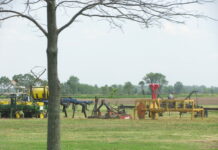Photo credit: DiasporaEngager (www.DiasporaEngager.com).
April 26, 2024 – CDC continues to respond to the public health challenge posed by a multistate outbreak of avian influenza A(H5N1) virus, or “A(H5N1) virus” in dairy cows and other animals in the U.S. CDC is working in collaboration with the U.S. Department of Agriculture (USDA), the Food and Drug Administration (FDA), state public health and animal health officials, and other partners using a One Health approach. USDA is now reporting that 34 dairy cattle herds in nine U.S. states, including most recently Colorado, have confirmed cases of A(H5N1) virus infections in cattle. The agency has issued a “Federal Order requiring Testing for and Reporting of Highly Pathogenic Avian Influenza (HPAI) in Livestock [118 KB, 2 pages].” Currently, one human case has been confirmed in a person with exposure to presumably infected dairy cows reported by Texas on April 1, 2024[1][2]. Monitoring people with exposure to animals infected or potentially infected with A(H5N1) viruses is important to help us better understand the risk to human health and potential for spread between animals and people.
CDC’s response to this outbreak of influenza A(H5N1) virus in dairy cattle and other animals most recently includes:
- An updated H5N1 Technical Report posted on April 26. This report updates a December 29, 2023, report to include seven new human cases of H5N1 reported globally since that time (five in Cambodia, one in the United States (Texas), and one in Vietnam) and recent activity in wild birds, poultry and other animals, including the multistate outbreak in U.S. dairy cattle and other animals, and updated information on monitoring for A(H5N1) virus infections in people in the United States. The report concludes that the current risk to the general public remains low at this time.
- Updated interim recommendations for worker protection expanded to include people who work in slaughterhouses posted on April 26.
- Continuing work to better characterize the virus from the human case in Texas.
-
- Testing for susceptibility to the commercially available and recommended flu antiviral medications was completed this week. Testing confirmed that the A(H5N1) virus from the human case in Texas[2] is susceptible to baloxavir marboxil, in addition to the neuraminidase inhibitors, which was announced last week. With these findings, the virus from the human case in Texas is confirmed to be susceptible to commercially available FDA-approved and recommended flu neuraminidase and polymerase acidic protein (PA) endonuclease inhibitor antiviral medications. Currently the neuraminidase inhibitor oseltamivir is recommended for antiviral treatment of people with confirmed or suspected A(H5N1) virus infection, and for post-exposure prophylaxis.
- Looking at antiviral resistance properties of more than 200 H5N1 publicly posted virus sequences from cattle. CDC found one virus from a cow with a marker known to be associated with reduced susceptibility to the neuraminidase inhibitors (a change at NA-T438I). This change has been seen rarely in the past in H5N1 viruses isolated from wild birds and poultry. The detection of this marker in one of more than 200 specimens is not surprising or concerning at this time in terms of the clinical usefulness of these drugs, but it does underscore why this kind of constant monitoring is important.
- Growing H5N1 virus stock from the one human case in Texas to use for additional laboratory experiments to:
-
-
- Learn how the virus reproduces in both human and cow respiratory tract epithelial cells and cow mammary epithelial cells.
- Assess the severity of illness and transmissibility of the virus under different scenarios by infecting ferrets and assessing the outcome. Ferrets are used as a model for people because they get sick and spread influenza viruses in a manner similar to humans.
-
-
- Testing human sera (blood) from people previously vaccinated with pre-pandemic A(H5) vaccines to see how it reacts to the virus from the human case in Texas. Data to date – including genetic analysis and testing of ferret antisera from multiple clade 2.3.4.4b candidate vaccine viruses – suggest vaccination will offer good cross-protection against cattle outbreak viruses. (The human case in Texas was a 2.3.4.4b virus.)
- Continuing to support states that are monitoring people with exposure to cows, birds, or other domestic or wild animals infected or potentially infected with influenza A(H5N1) viruses. Testing of symptomatic people who have exposures is being done by state or local officials, and CDC is conducting confirmatory testing when needed.
- Maintaining multilingual and multidisciplinary epidemiological field teams ready to deploy for on-site studies to better understand the current outbreak, particularly the public health and One Health implications of the emergence of this virus in cattle.
- Engaging One Health partner organizations from public health, agriculture, wildlife, milk regulatory officials, and others to share information and ensure preparedness to prevent and respond to this emerging infectious disease threat and for any potential human infections. On April 25, CDC participated in an ASTHO-hosted discussion between public health leaders and scientists leading the U.S. Government’s response to Highly Pathogenic Avian Influenza (HPAI).
- Continuing to monitor flu surveillance data, especially in areas where A(H5N1) viruses have been detected in dairy cattle or other animals, for any unusual trends in flu-like illness, flu, or conjunctivitis. CDC this week posted a webpage on How CDC is monitoring influenza data in people to better understand the current avian influenza A (H5N1) situation | Avian Influenza (Flu). CDC flu surveillance systems show no indicators of unusual flu activity in people, including avian influenza A(H5N1) for the most recent week.
New Measures to Contain Spread in Cows
The multistate outbreak of HPAI A(H5N1) bird flu in dairy cows was first reported by USDA on March 25, 2024. This is the first time that A(H5N1) viruses have been found in cattle. USDA also has reported that the virus has spread through cattle movement between herds and also from dairy cattle premises into nearby poultry premises and has infected a number of barn cats. Additionally, USDA has reported that APHIS National Veterinary Services Laboratories found virus in a lung tissue sample from a dairy cow without symptoms that came from an affected herd (but that cow did not enter the food supply). This week, USDA issued a “Federal Order Requiring Testing for and Reporting of Highly Pathogenic Avian Influenza in Livestock [118 KB, 2 pages]” to protect livestock health. Prior to interstate movement, dairy cattle are now required to receive a negative test for influenza A virus at an approved National Animal Health Laboratory Network laboratory. For more information regarding this Federal Order visit HPAI Detections in Livestock. Containing spread of this virus in animals will help reduce the number of potential human exposures and thus help contain the public health risk.
Ongoing Surveillance Needed
Because of the potential for influenza viruses to constantly change, continual surveillance and preparedness efforts are critical, and CDC is taking measures to be ready in case the current risk assessment for the general public changes. The immediate goal is to prevent further spread of this virus between animals and people. CDC will continue to monitor these viruses and update and adjust guidance as needed. As a reminder, while CDC believes the current risk of A(H5N1) infection to the general public remains low, people with close, prolonged, or unprotected exposures to infected birds, cattle, or other animals, to unpasteurized (“raw”) milk, or to environments contaminated by infected birds, cattle, or other animals or by raw milk, are at a greater risk of infection.
CDC has interim recommendations for prevention, monitoring, and public health investigations of A(H5N1) virus infections in people. CDC also has updated recommendations for worker protection and use of personal protective equipment (PPE) to reduce their risk of exposure. Following these recommendations is central to reducing a person’s risk and containing the overall public health risk.
This is a rapidly changing situation, and CDC is committed to providing frequent and timely updates.
Source of original article: Centers for Disease Control and Prevention (CDC) / Seasonal Flu (tools.cdc.gov).
The content of this article does not necessarily reflect the views or opinion of Global Diaspora News (www.GlobalDiasporaNews.com).
To submit your press release: (https://www.GlobalDiasporaNews.com/pr).
To advertise on Global Diaspora News: (www.GlobalDiasporaNews.com/ads).
Sign up to Global Diaspora News newsletter (https://www.GlobalDiasporaNews.com/newsletter/) to start receiving updates and opportunities directly in your email inbox for free.































